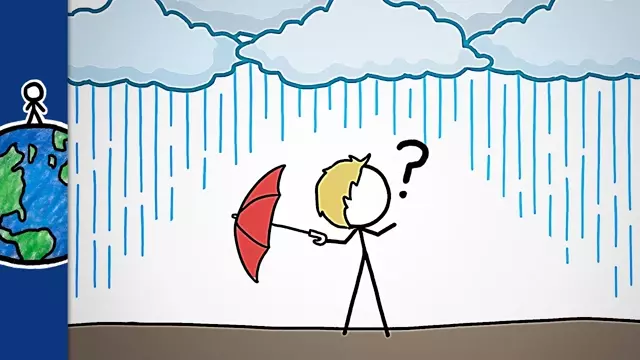2017-05-10
[public] 587K views, 15.3K likes, dislikes audio only
Less than half of the rain that falls from a cloud makes it all the way to the ground – because a lot evaporates while falling or after landing in treetops.
Thanks to Georgia Southern University for sponsoring this video. Thanks also to our supporters on https://www.patreon.com/MinuteEarth
You can see more of John Van Stan's research here: https://www.researchgate.net/profile/John_Van_Stan2
___________________________________________
FYI: We try to leave jargon out of our videos, but if you want to learn more about this topic, here are some keywords to get your googling started:
Virga: an observable shaft of precipitation falling from a cloud that evaporates before reaching the ground
Rainfall interception: The fraction of rainfall that falls on leaves, branches and trunks of trees and evaporates before dripping to the ground.
___________________________________________
Credits (and Twitter handles):
Script Writer: Peter Reich
Script Editor: Alex Reich (@alexhreich)
Video Illustrator: Qingyang Chen (@QCVisual)
Video Director: Kate Yoshida (@KateYoshida)
Video Narrator: Kate Yoshida (@KateYoshida)
With Contributions From: Henry Reich, Ever Salazar, Emily Elert, David Goldenberg
Music by: Nathaniel Schroeder: http://www.soundcloud.com/drschroeder
_________________________________________
Like our videos?
Subscribe to MinuteEarth on YouTube: http://goo.gl/EpIDGd
Support us on Patreon: https://goo.gl/ZVgLQZ
Also, say hello on:
Facebook: http://goo.gl/FpAvo6
Twitter: http://goo.gl/Y1aWVC
And find us on itunes: https://goo.gl/sfwS6n
___________________________________________
References:
Good, S.P., Noone, D. and Bowen, G., 2015. Hydrologic connectivity constrains partitioning of global terrestrial water fluxes. Science, 349(6244), pp.175-177.
Langhans, W., Yeo, K. and Romps, D.M., 2015. Lagrangian investigation of the precipitation efficiency of convective clouds. Journal of the Atmospheric Sciences, 72(3), pp.1045-1062.
Miralles, D.G., Gash, J.H., Holmes, T.R., de Jeu, R.A. and Dolman, A.J., 2010. Global canopy interception from satellite observations. Journal of Geophysical Research: Atmospheres, 115(D16).
Oki, T. and Kanae, S., 2006. Global hydrological cycles and world water resources. science, 313(5790), pp.1068-1072.
Sadeghi, S.M.M., Attarod, P., Van Stan, J.T. and Pypker, T.G., 2016. The importance of considering rainfall partitioning in afforestation initiatives in semiarid climates: A comparison of common planted tree species in Tehran, Iran. Science of the Total Environment, 568, pp.845-855.
Van Stan, J.T., Levia Jr, D.F. and Jenkins, R.B., 2015. Forest canopy interception loss across temporal scales: Implications for urban greening initiatives. The Professional Geographer, 67(1), pp.41-51.
http://patreon.com/minuteearth
/youtube/channel/UCeiYXex_fwgYDonaTcSIk6w
https://www.patreon.com/minuteearth
/youtube/video/4DF94Wvtekk

